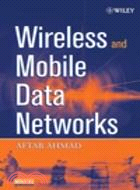| FindBook |
有 1 項符合
WIRELESS AND MOBILE DATA NETWORKS的圖書 |
 |
WIRELESS AND MOBILE DATA NETWORKS 作者:AHMAD 出版社:JOHN WILEY & SONS,INC. 出版日期:2005-01-01 |
| 圖書館借閱 |
| 國家圖書館 | 全國圖書書目資訊網 | 國立公共資訊圖書館 | 電子書服務平台 | MetaCat 跨館整合查詢 |
| 臺北市立圖書館 | 新北市立圖書館 | 基隆市公共圖書館 | 桃園市立圖書館 | 新竹縣公共圖書館 |
| 苗栗縣立圖書館 | 臺中市立圖書館 | 彰化縣公共圖書館 | 南投縣文化局 | 雲林縣公共圖書館 |
| 嘉義縣圖書館 | 臺南市立圖書館 | 高雄市立圖書館 | 屏東縣公共圖書館 | 宜蘭縣公共圖書館 |
| 花蓮縣文化局 | 臺東縣文化處 |
|
|
- 圖書簡介
Wireless and Mobile Data Networks provides a single point of knowledge about wireless data technologies, including: * Comprehensive easy-to understand resource on wireless data technologies * Includes wireless media, data transmission via cellular networks, and network security * Provides a single point of knowledge about wireless data * Focuses on wireless data networks, wireless channels, wireless local networks, wide area cellular networks and wireless network security An Instructor Support FTP site is available from the Wiley editorial department.
- 作者簡介
AFTAB AHMAD received his DSc in communications from The George Washington University. Currently, he is Associate Professor of Computer Science at Norfolk State University. He has published a number of research papers and a book, Data Communication Principles: For Fixed and Wireless Networks. His current research involves ad hoc network routing, wireless network planning, Quality of Service (QoS)–based call control in IP radio access networks (IP-RAN), and QoS routing with IP.
- 名人/編輯推薦
"...its coverage of timely materials makes this book a good choice for teaching about wireless mobile and data networks..." (Computing Reviews.com, June 13, 2006)
"The book is well written and illustrated…recommended." (CHOICE, January 2006) - 目次
PREFACE.
ACKNOWLEDGMENTS.
1. WIRELESS DATA—INTRODUCTION.
1.1. Wireless Voice.
1.2. Wireless Local Area Networks (WLANs).
1.3. Wide Area Cellular Networks.
1.4. Fixed Wireless Networks.
1.5. Personal Area Networks.
1.6. Satellite-Based Data Networks.
1.7. Mobile IP.
1.8. The Wireless Spectrum.
2. REFERENCE ARCHITECTURES FOR WIRELESS DATA NETWORKS.
2.1. Bluetooth.
2.2. IEEE 802.11.
2.3. HIPERLAN/2.
2.4. Broadband Wireless Access Networks.
2.5. Cellular Data Networks.
2.6. Summary.
3. COMPONENTS OF A WIRELESS LAN.
3.1. Local Area Networks (LANs).
3.2. Wireless LAN Components.
4. WLANs: THE PHYSICAL LAYER.
4.1. IEEE 802.11 Standards Suite.
4.2. Interference Rejection Using Barker Sequence, OFDM and CCK.
4.3. HIPERLAN PHY.
4.4. Summary.
5. WLANs: MEDIUM ACCESS CONTROL.
5.1. IEEE 802.11 Medium Access Control.
5.2. IEEE 802.11e factor.
5.3. Routing and Mobility Support.
5.4. MAC Layer Management.
5.5. MAC Frames.
5.6. Multicasting Capability.
5.7. HIPERLAN MAC.
5.8. HIPERLAN 2.
5.9. User and Data Privacy.
5.10. Power Management.
5.11. Multimedia Services.
5.12. Routing.
5.13. Mobility Support.
5.14. MAC Frame.
5.15. Teleconferencing Capability.
5.16. Data Link Control (DLC) Layer.
6. MOBILITY AND INTERNET PROTOCOLS.
6.1. Mobility in Internet Applications.
6.2. Internet Protocols for Mobility.
6.3. Session Initiation Protocol (SIP).
6.4. Mobile IP.
6.5. Mobility Management in an Access Network.
6.6. Cellular IP.
6.7. IPv6 and Mobility Management.
7. DATA COMMUNICATIONS IN CELLULAR NETWORKS: CDMA2000.
7.1. Business Wireless Data Networks.
7.2. Cellular Data Networks.
7.3. Release D for cdma2000 Based Access.
7.4. cdma2000 Standard.
7.5. cdma2000 Medium Access Control.
7.6. All-IP Architecture.
7.7. Summary.
8. DATA COMMUNICATIONS IN CELLULAR NETWORKS: W-CDMA.
8.1. Components of the UMTS Network.
8.2. UMTS Network Domains.
8.3. Strata.
8.4. Radio Access Network (RAN).
8.5. UMTS Services.
8.6. Improvements Over Release 99.
8.7. IMS System Concepts.
8.8. Session Layer Architecture.
8.9. Open Service Access (OSA).
8.10. Parlay.
8.11. IPv4/IPv6 Scenarios Towards All-IP Infrastructure.
8.12. 3GPP Release 6 Objectives.
8.13. Summary.
9. SECURITY IN WIRELESS DATA NETWORKS.
9.1. Ascribing Security to a Network.
9.2. Security Network Architecture.
9.3. Secure Operating System (SOS).
9.4. Components of Security System.
9.5. Wireline Equivalent Privacy (WEP).
9.6. Wi-Fi Protected Access (WPA).
9.7. IEEE 802.11i.
9.8. Security in Cellular Networks.
9.9. Final Word.
10. ROUTING IN WIRELESS LANs.
10.1. Routing in Infrastructure Networks.
10.2. Ad Hoc Wireless Networks.
10.3. Characteristics of a Good Routing Protocol.
10.4. Classifications of Routing Protocols.
10.5. Routing Phases.
10.6. Routing Mechanisms.
10.7. Performance Comparison.
10.8. Multicasting.
10.9. Dynamic Source Routing (DSR) Protocol.
10.10. Selecting the Best Route.
10.11. WLAN Routing Through Cellular Network Infrastructure.
10.12. Routing in Personal Area Networks.
10.13. Summary.
11. WIRELESS PERSONAL AREA NETWORKS AND ULTRAWIDE BAND COMMUNICATIONS.
11.1. Wireless Personal Area Networks (WPANs).
11.2. Terminology for WPANs.
11.3. IEEE 802.15.1 Standard.
11.4. Higher Data Rate PANs (IEEE 802.15.3).
11.5. Ultra Wideband (UWB) Spectrum.
11.6. Low Data Rate WPANs (LR-WPANs) and IEEE 802.15.4.
11.7. Summary.
12. BROADBAND WIRELESS ACCESS (BWA).
12.1. Line-of-Site (LoS) and Non-Line-of-Site (NLoS) Systems.7
12.2. Effect of Antenna Type.
12.3. BWA Spectrum.
12.4. BRAN versus WirelessMAN.
12.5. IEEE WirelessMAN.
12.6. IEEE 802.20 Mobile Broadband Wireless Access (MBWA).
12.7. Cellular and Satellite Networks as Wireless Local Loops (WLL)s.
APPENDIX: OVERVIEW AND GUIDE TO THE IEEE 802 LMSC.
INDEX.
|










